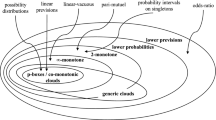Abstract
In this paper, we study a trilevel decision-making situation in which decisionmaker 1 selects an action, within a specified constraint set, then decisionmaker 2 selects an action within a constraint set determined by the action of decisionmaker 2, and finally decisionmaker 3 selects an action within a constraint set determined by the actions of decisionmakers 1 and 2. Each decisionmaker has an objective function to be optimized within the imposed constraint set. Bard (Ref. 1) presents a five-step algorithm for solving this problem. This paper presents an alternative approach to the key first step of that algorithm, which has some qualitative advantages over it.
Similar content being viewed by others
References
Bard, J. F., An Investigation of the Linear Three-Level Programming Problem, IEEE Transactions on Systems, Man, and Cybernetics, Vol. 14, pp. 711–717, 1984.
Wen, U. P., and Hsu, S. T., Linear Bilevel Programming Problems: A Review, Journal of the Operational Research Society, Vol. 42, pp. 125–134, 1991.
Vincente, L. N., and Calamai, P., Bilevel and Multilevel Programming: A Bibliography Review, Journal of Global Optimization, Vol. 5, pp. 291–306, 1994.
Wen, U. P., and Bialas, W., The Hybrid Algorithm for Solving the Three-Level Programming Problem, Computers and Operations Research, Vol. 13, pp. 367–377, 1986.
Benson, H. P., On the Structure and Properties of a Linear Multilevel Programming Problem, Journal of Optimization Theory and Applications, Vol. 9, pp. 353–373, 1989.
Bard, J., and Falk, J., An Explicit Solution to the Multilevel Programming Problem, Computers and Operations Research, Vol. 9, pp. 77–100, 1982.
Cassidy, R. G., Kirby, M. J. L., and Raike, W. M., Efficient Distribution of Resources through Three Levels of Government, Management Science, Vol. 17B, pp. 462–473, 1971.
Wen, U. P., Mathematical Methods for Multilevel Linear Programming, PhD Dissertation, Department of Industrial Engineering, State University of New York at Buffalo, 1981.
Zangwill, W. I., Nonlinear Programming: A Unified Approach, Prentice Hall, Englewood Cliffs, New Jersey, 1969.
White, D. J., and Anandalingam, G., A Penalty Function Approach for Solving Bilevel Linear Programs, Journal of Global Optimization, Vol. 3, pp. 397–419, 1993.
Tuy, H., Concave Programming under Linear Constraints, Soviet Mathematics, Vol. 5, pp. 1437–1440, 1964.
Sherali, H. D., and Shetty, C. M., A Finitely Convergent Algorithm for Bilinear Programming Problems Using Polar Cuts and Disjunctive Face Cuts, Mathematical Programming, Vol. 12, pp. 14–31, 1980.
Konno, H., A Cutting-Plane Algorithm for Solving Bilinear Programs, Mathematical Programming, Vol. 11, pp. 14–27, 1976.
Author information
Authors and Affiliations
Rights and permissions
About this article
Cite this article
White, D.J. Penalty Function Approach to Linear Trilevel Programming. Journal of Optimization Theory and Applications 93, 183–197 (1997). https://doi.org/10.1023/A:1022610103712
Issue Date:
DOI: https://doi.org/10.1023/A:1022610103712




